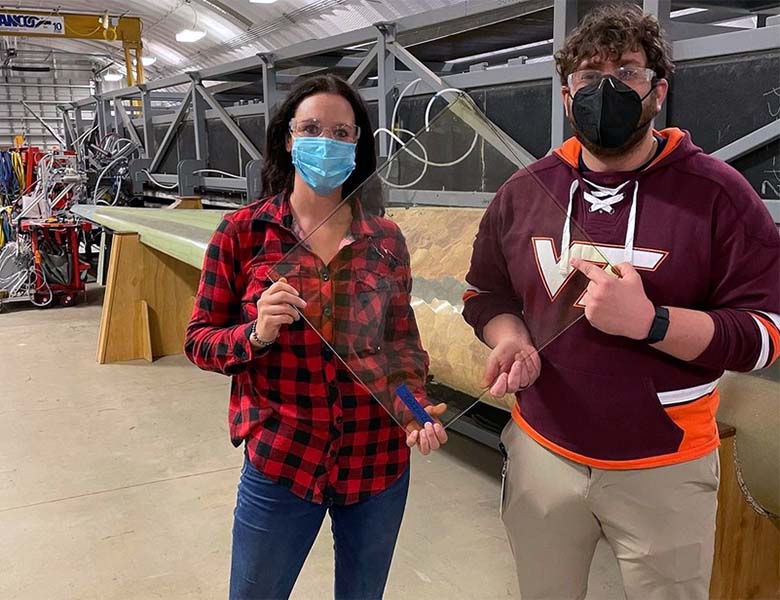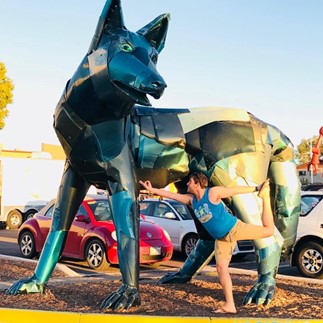Q&A With Nicholas Rorrer: Plant-Based Plastics and Plastic Plants
Manufacturing Mastermind Series

By age nine, Nicholas Rorrer was busy staining T-shirts with ketchup.
Rorrer was not a messy kid. Quite the opposite; his ketchup stains were part of a surprisingly well-controlled experiment on how various soaps work on stains of all colors.
Today, Rorrer, who is a senior researcher at the National Renewable Energy Laboratory (NREL), studies how to clean up a very different, far more complicated mess—plastics, or rather the molecular building blocks (called polymers) behind these bitter-sweet materials.
Plastic pollution might be one of today’s most pressing environmental problems, but polymers provide environmental solutions, too. The first plastics were invented to replace ivory and tortoiseshell to save wild elephants and tortoises from slaughter. Polymers also come with smaller carbon footprints than other materials and cause fewer greenhouse gas emissions during manufacturing.
“It’s very possible our future society runs on plastics,” Rorrer said. “I’m not going to lie and say we do a good job of handling end-of-life materials. It's terrible. But that’s true for a lot of things, like my metal water bottle, food waste, and sustainable fuels and products. So, the question is: How do I redesign plastics to be reused?”
Rorrer and his NREL colleagues are getting close. So far, they accidentally designed a microbial enzyme that eats polymers—and the scraps can then be built into new plastics and goods. They are also inventing ways to manufacture polymers with biobased (or plant-based) materials, like corn, and upcycle reclaimed polymers into superior plastics.
In the latest Manufacturing Masterminds Q&A, Rorrer shares why he loves polymers as well as Legos, yoga, RuPaul’s drag races, and saving the world. This interview has been edited for clarity and length.

That plant behind you—is that real?
No. It’s made of Legos, which are, of course, plastic. I am very much into Legos.
Neat! I have a plastic plant, too.
That’s PVC, a very common plastic. In Susan Freinkel’s book "Plastic: A Toxic Love Story," she wrote that plastics are artists. They can take any size or shape that the mind imagines. And it's true. I showed you a plant made of Legos. You have a plant made of PVC. Two different plastics, both in the shape of a plant.
OK, plastic plants aside, let’s get into your work on plant-based plastics. Did you always know you’d go into science?
I was the kid who liked to do every science fair project ever. My parents always said I would end up in engineering or chemical engineering. And my dad kept giving me a hard time, saying the key to success was going to Virginia Tech. I thought about not going just to spite my father. But I did anyway. One of my life mottos has been to do good in your own small corner of the world. And I realized I have the natural wiring to be good at chemical engineering.
Even so, you were hesitant to go to graduate school, right?
I didn’t think I was fit for graduate school. I had no delusions of grandeur. But once my advisor [William Ducker] said I should go, I applied and got into the Colorado School of Mines right down the road from NREL.
Right. That’s when you got curious about polymers. What drew you to them?
They're everywhere. They're used in every facet of modern life, like my Legos and polyester clothes, which is the same polymer used in plastic water bottles. There will always be a job in plastics because they are such prolific materials.
For much of your Ph.D., you studied how polymers behave on a molecular level and how those behaviors translate into different properties, like pliability, strength, or recyclability. What led you to NREL?
I really wanted to get experimental experience. So, I applied for the U.S. Department of Energy’s Office of Science Graduate Student Research Award and got it. That let me join NREL, first as a graduate student and then as a postdoctoral researcher, working to make crazy polymer molecules from biomass [plant materials] instead of petrochemicals [fossil fuels].
Back then, almost no one at NREL was making polymers. But when we published our paper on upcycling the polyester called polyethylene terephthalate (PET), the tides turned, and plastics got a lot more interesting [PET is an abundant and tough but not yet recyclable kind of plastic]. Then I wrote a paper about PET upcycling into wind turbines. That’s when I became a staff scientist.
Congratulations. But you could have gone anywhere. Why NREL?
I’ll go back to my cheesy little axiom: Do good in your small corner of the world. NREL’s impact is much bigger than other organizations'. At first, I was like, “Man. I'll never get a job here. I'll never be like these giants.” But I think everyone has impostor syndrome.
Yet here you are! Plastics probably have imposter syndrome, too. What would you say about their evil reputation?
Plastics get demonized so much. But they're also lightweight materials. They generate fewer greenhouse gases to manufacture than other materials. They can be bioderived [meaning, created from biological materials like sugars and corn instead of the traditional fossil fuels]. Plastics are organic. They're not this rare resource. We just don't have good end-of-life solutions for them.
And you’re trying to solve that problem while also trying to make better plastics in the first place, right?

I’m focused on how we can manufacture better plastics. Like, if I can make a plastic nylon that has a lower water permeability, it might get adopted. Or, what if we can redesign plastics to be recyclable by design?
We've done that with carbon fiber. Carbon fiber is great—it's lightweight, high strength. It can make vehicles more efficient and use less energy. But one of the biggest issues is its greenhouse gas emissions. If you reuse that fiber, you can reduce the greenhouse gas impact. Our carbon fiber composites might one day replace steel in vehicles.
So, are you saying we need to make recyclable plastics the better option to get industry to adopt them?
There's huge debate here, but the short answer is yes. If we can't compete on costs, how can we compete? Maybe we make the manufacturing process safer, faster, or less energy intensive. Or maybe we manufacture something that performs better. Like, my computer fan is nylon 610, which is a biobased material. It’s used because it has less water absorption than other nylons, not because its biobased. Compostable cups are based on polylactic acid, which has a big market not because it’s compostable but because it’s great for refrigerator linings and in 3D printers.
Got it. You’ve got a knack for explaining all this clearly.
That's been a big thing in my career—learning not to speak polymers all the time and using accessible language.
Why?
I want more people in science who don't look like me. But I've learned how hard it can be to make science accessible even when talking to a room full of Ph.D. students.
So, have you been successful at communicating science more effectively?

Before the pandemic, staff in NREL’s education programs would ask me to talk to high schoolers about plastics. I told them I make Legos out of corn and that we can combine a water bottle with some biomass and get a snowboard. I’m a big snowboarder. It’s my dream for a Colorado company to make a snowboard with one of our plant-based resins.
Obviously, we’re all grateful you’re a scientist and not a full-time snowboarder. But if you ever quit science, what would you do?
I would open a coffee shop so I can have good baked goods. I also used to teach yoga at NREL. But I’d probably be a band teacher. I went to Virginia Tech the year after the April 16, 2007, shootings. It had a big, transformative effect on my life. I remember debating with my parents about whether it was safe to go. And I said, “If I don't go to Virginia Tech, I'll go to the University of North Carolina and major in music instead.”
And you still play baritone horn today. When you’re not listening to your own music, what podcasts do you listen to?
“The Daily” from The New York Times every day. On Wednesday, “Race Chaser,” which is a podcast about RuPaul's drag race. I also love “Harry Potter and the Sacred Text.” Since the beginning of the pandemic, there are times when I can't take news stories anymore.
For the kids who want to be like you and pursue a career in science, technology, engineering, and mathematics (STEM), what advice would you give?
We don't get a greener world without a firm foundation of science. It's like the dating advice I gave during some of my leadership talks: It's about being comfortable with yourself. Engineers are awkward. I can be a very awkward person. I would not be as good as I am if I were not comfortable with who I am. So, if you want to change the world, go into STEM. But also accept who you are.
Interested in building a clean energy future? Read other Q&As from NREL researchers in Advanced Manufacturing, and browse open positions to see what it is like to work at NREL.
Last Updated May 28, 2025
